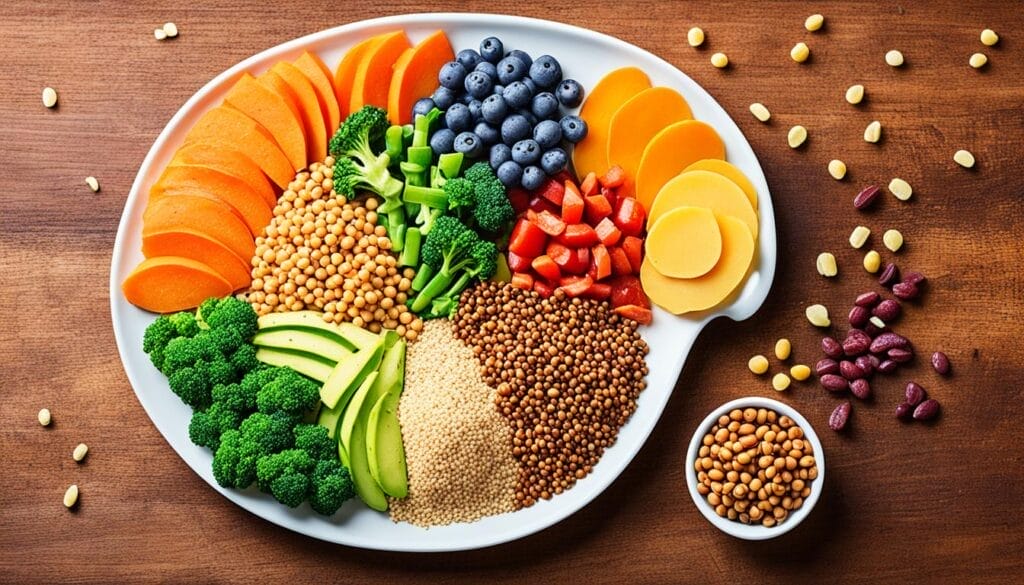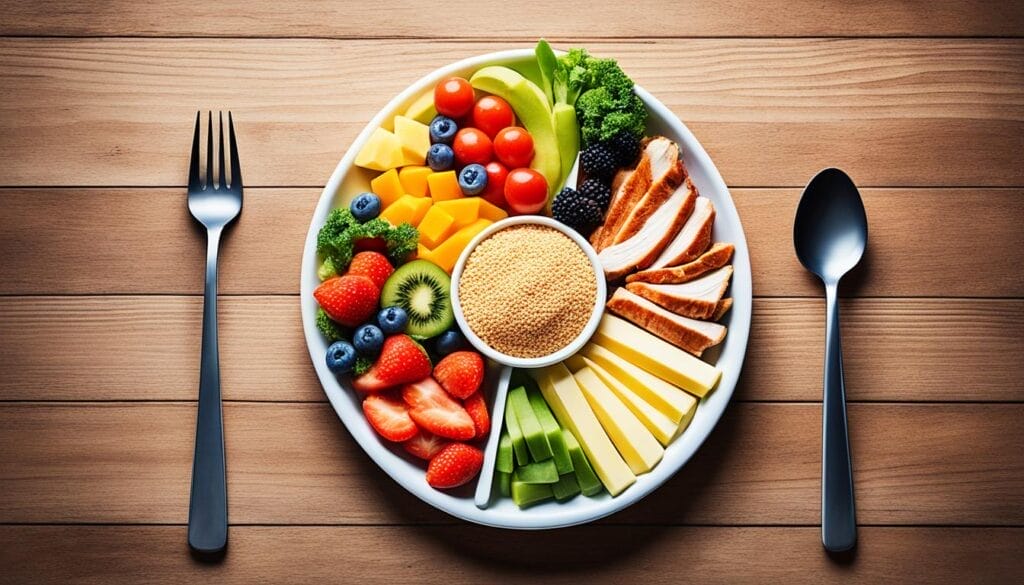Growing up, I always had a passion for cooking. Experimenting with different flavors and creating delicious meals brought me joy and satisfaction. However, as I entered adulthood and faced the challenges of a busy lifestyle, I found it increasingly difficult to maintain a balanced diet. Convenience often trumped nutrition, and I turned to unhealthy fast food options more often than I’d like to admit.
One day, after feeling sluggish and unhappy with my body, I knew I had to make a change. That’s when I discovered the power of healthy meal planning. By taking the time to plan my meals in advance, I was able to regain control of my diet and ensure that I was nourishing my body with the right nutrients.
Healthy meal planning, I soon realised, is not about restrictive diets or endless sacrifices. It’s about making smart choices, finding the right balance, and enjoying delicious meals that fuel your body. In this article, I want to share with you my top tips for healthy meal planning that will help you achieve a balanced diet without feeling deprived.
Key Takeaways
- Healthy meal planning can help you maintain a balanced diet.
- It’s important to focus on calorie balance and nutrient intake.
- Include starchy carbohydrates, fruits, vegetables, and healthy proteins in your meals.
- Limit your intake of saturated fat, sugar, and salt.
- Stay hydrated and make mindful choices when it comes to food and drink.
The Importance of Calorie Balance and Nutrient Intake
When it comes to maintaining a healthy diet, two key factors to consider are calorie balance and nutrient intake. These elements play a crucial role in ensuring that our bodies receive the right amount of energy and essential nutrients they need to function optimally.
Calorie balance refers to the equilibrium between the calories we consume through food and beverages and the calories we burn through physical activity. It’s important to strike the right balance to achieve and maintain a healthy weight. Consuming more calories than we need can lead to weight gain, while not consuming enough can result in weight loss.
For men, the recommended daily calorie intake is around 2,500 calories, while women should aim for around 2,000 calories per day. However, these figures can vary depending on factors such as age, height, weight, and activity level.
In addition to calorie balance, focusing on nutrient intake is equally important. Our bodies require a wide range of essential nutrients to support overall health and wellbeing. By consuming a variety of foods from different food groups, we can ensure that we’re getting all the necessary vitamins, minerals, and other nutrients our bodies need to thrive.
Eating a diverse range of foods can help us meet our nutritional needs and prevent deficiencies. It’s important to include foods from each major food group, such as:
- Fruits and vegetables
- Whole grains
- Lean proteins
- Dairy or dairy alternatives
- Healthy fats
By incorporating these foods into our daily meals, we can provide our bodies with the essential nutrients they require for optimal health.
| Gender | Calories per Day |
|---|---|
| Men | 2,500 calories |
| Women | 2,000 calories |
Building a Balanced Plate with Starchy Carbohydrates and Fibre
When it comes to creating a well-balanced meal, starchy carbohydrates and fibre play a crucial role. Starchy carbohydrates, such as potatoes, rice, pasta, and bread, should make up a third of your plate. Contrary to popular belief, starchy foods are not fattening and actually provide fewer calories than fat. The key is to choose the right types of carbohydrates and be mindful of the fats you add when preparing these foods.
Opt for wholegrain or higher fibre varieties of starchy carbohydrates. Not only do they offer a range of nutrients, but they also provide more fibre, which is important for digestive health. Fibre promotes regular bowel movements, helps keep you feeling full for longer, and can aid in weight management. Include at least one starchy food with each main meal to ensure you’re getting enough energy to fuel your day.
Here are some examples of wholegrain or higher fibre starchy foods to include in your meals:
- Wholegrain bread
- Brown rice
- Wholewheat pasta
- Quinoa
- Oats
These options will not only provide the necessary carbohydrates for energy but also contribute to your daily fibre intake. Remember to vary your choices to keep your meals interesting and reap the benefits of different nutrients.
By incorporating starchy carbohydrates and fibre into your meals, you are providing your body with essential fuel for daily activities and supporting healthy digestion. Next, we’ll explore the importance of incorporating fruits and vegetables into your meals to further enhance your balanced diet.

Incorporating Fruits and Vegetables into Your Meals
A healthy and balanced diet is incomplete without the inclusion of fruits and vegetables. These nutrient-rich foods provide essential vitamins, minerals, and fibre, while also helping to reduce the risk of various diseases. It is recommended to consume at least 5 portions of fruits and vegetables every day, and they can be incorporated into meals as well as snacks.
| Type | Examples |
|---|---|
| Fresh | Apples, bananas, carrots, tomatoes |
| Frozen | Blueberries, peas, spinach, mixed vegetables |
| Canned | Pineapple, sweetcorn, beans, tomatoes |
| Dried | Raisins, apricots, dates, prunes |
| Juiced | Orange juice, vegetable juice |
When incorporating fruits and vegetables into your meals, try to choose a variety of different types and colours to ensure a wide range of nutrients. They can be enjoyed as side dishes, added to salads, stirred into stir-fries, or blended into smoothies. The possibilities are endless!
“Eating fruits and vegetables is a delicious way to nourish your body and support your overall health.”
While fruit juices and smoothies can be a convenient way to consume fruits and vegetables, it’s important to be mindful of their sugar content. They can be high in natural sugars and should be limited to one glass a day. Instead, opt for whole fruits and vegetables that provide additional fibre and nutrients.
By incorporating a variety of fruits and vegetables into your meals, you can enhance the nutritional value of your diet and enjoy a wide range of flavours and textures.
Choosing Healthy Protein Sources
When it comes to protein, fish is a fantastic choice for a healthy and balanced diet. Incorporating fish into your meals at least twice a week can provide numerous health benefits. Additionally, including oily fish, such as salmon or mackerel, in one of those servings offers even greater advantages.
Fish is not only a good source of protein, but it also contains essential vitamins and minerals that are essential for overall health and well-being. Oily fish, in particular, is high in omega-3 fats, which are known to promote heart health. These beneficial fats play a crucial role in maintaining cardiovascular health and reducing the risk of heart disease.
While oily fish takes the spotlight, non-oily fish like cod and tuna are also valuable sources of protein. They provide a lean and nutritious option for those who may not prefer the taste of oily fish. Whether you choose fresh, frozen, or canned fish, incorporating these protein-rich options into your diet is a wonderful way to support your health goals.
However, it is important to be mindful of the salt content found in canned and smoked fish. While they can still be part of a healthy diet, it is essential to monitor your salt intake and choose lower-sodium options whenever possible.

| Benefits of Choosing Fish as a Protein Source | Considerations |
|---|---|
| Good source of protein | Monitor salt content in canned and smoked fish |
| Contains essential vitamins and minerals | |
| Oily fish is high in heart-healthy omega-3 fats | |
| Non-oily fish like cod and tuna are also beneficial |
Reducing Saturated Fat and Sugar Intake
When it comes to maintaining a healthy diet, it’s important to pay attention to the amount of saturated fat and sugar we consume. Too much saturated fat can increase the risk of heart disease, while excess sugar can contribute to weight gain and tooth decay. To keep our bodies in top shape, let’s explore some tips for reducing saturated fat and sugar in our diets.
Limiting Saturated Fat
To minimise our intake of saturated fat, it’s crucial to make mindful choices about the foods we choose. Some key tips include:
- Avoiding fatty cuts of meat
- Replacing butter with healthier alternatives
- Opting for low-fat or fat-free dairy products
Additionally, incorporating more unsaturated fats into our meals can have long-term benefits for our health. Good sources of unsaturated fats include:
- Vegetable oils like olive oil or canola oil
- Oily fish such as salmon, mackerel, or sardines
- Avocados
Reducing Sugar Intake
Excessive sugar consumption can have negative effects on our overall health. To cut back on sugar, consider the following strategies:
- Avoiding sugary drinks like soda and fruit juices
- Opting for lower-sugar alternatives when choosing packaged foods
- Making homemade snacks and desserts with less added sugar
It’s important to check food labels for hidden sugars and choose products with lower sugar content whenever possible.

Managing Salt Intake and Staying Hydrated
Excessive salt intake can raise blood pressure, increasing the risk of heart disease and stroke. It’s important to be mindful of the salt content in our diet to maintain good health.
When it comes to managing salt intake, keeping an eye on the sodium content of packaged foods is crucial. Many processed foods, such as canned soups, sauces, and snacks, contain high levels of sodium. It’s best to opt for fresh, homemade alternatives whenever possible.
“I always check food labels for sodium content before buying any packaged foods. It’s surprising how quickly those sodium levels can add up!” – Emma, a health-conscious individual.
Instead of relying on salt alone for flavouring meals, try using herbs and spices, like rosemary, thyme, or basil, to enhance the taste. Squeezing a little citrus juice, like lemon or lime, can also add a burst of flavour without extra salt. These simple swaps can make a big difference in reducing salt intake while still enjoying delicious meals.
Staying hydrated is equally important for overall health and well-being. Drinking plenty of water throughout the day helps maintain proper bodily functions and keeps us feeling refreshed. When it comes to hydration, it’s best to prioritise water as the main beverage choice.
Avoid sugary drinks, such as soda or sweetened fruit juices, as they can contribute to weight gain and have negative effects on our health. Instead, limit fruit juice consumption to a small glass per day. If you’re looking for flavour, try infusing water with slices of fruit or herbs for a refreshing and hydrating twist.
“I always carry a reusable water bottle with me, and I fill it up whenever I can. It’s a great reminder to stay hydrated throughout the day!” – David, gym go-er.
It’s especially important to be mindful of fluid intake in hot weather or during physical activity to prevent dehydration. As a general guideline, aim to drink at least 8 cups (2 litres) of water per day. However, individual needs may vary depending on factors such as age, gender, and activity level.
Stay healthy by managing your salt intake and staying hydrated. By being mindful about the sodium content in packaged foods, using herbs and citrus for flavour, and prioritising water as your go-to beverage, you can take small yet impactfull steps toward better health.

Summing It Up
Healthy eating is essential for a balanced diet and overall wellbeing. By following these tips and incorporating them into your meal planning, you can create nutritious meal plans that support your health and lifestyle goals. Remember to include a variety of foods from different food groups to ensure you get all the necessary nutrients.
Focus on whole grains, such as brown rice and whole wheat bread, as well as lean proteins like chicken and fish. Don’t forget to include plenty of fruits and vegetables, which are packed with vitamins, minerals, and fibre.
When planning your meals, be mindful of your intake of saturated fat, sugar, and salt. Opt for healthier fats found in vegetable oils and avocados, and limit your consumption of sugary drinks and foods high in added sugars. Monitor the sodium content of packaged foods and season your meals with herbs and citrus instead of salt.
By incorporating these healthy eating tips into your meal plans and experimenting with nutritious and delicious recipes, you can enjoy a well-balanced diet that promotes good health and leaves you feeling energised and satisfied.
FAQ
What is healthy meal planning?
Healthy meal planning involves making conscious choices about the types and amounts of food we eat to ensure we are getting all the necessary nutrients while maintaining a calorie balance.
How many calories should I aim for each day?
Men should aim for around 2,500 calories a day, while women should aim for around 2,000 calories a day.
What should I include in my meals to promote a balanced diet?
Starchy carbohydrates, such as potatoes, rice, pasta, and bread, should make up a third of your meal. Opt for wholegrain or higher fibre varieties. Aim to eat at least 5 portions of fruits and vegetables each day. Include fish in your diet at least twice a week, including one portion of oily fish like salmon or mackerel.
Can I eat starchy carbohydrates if I want to lose weight?
Yes, you can. Starchy foods are not fattening and provide fewer calories than fat. Just be mindful of the fats you add when preparing these foods.
How can I incorporate fruits and vegetables into my meals?
Aim to eat at least 5 portions of fruits and vegetables each day. These can be fresh, frozen, canned, dried, or juiced. Include them in your meals as well as snacks.
Why is fish a good choice for a balanced diet?
Fish is a good source of protein and contains essential vitamins and minerals. Oily fish is high in omega-3 fats, which promote heart health.
How can I reduce saturated fat and sugar intake?
Limit your intake of fatty cuts of meat, butter, cream, and high-fat dairy products. Opt for unsaturated fats found in vegetable oils, oily fish, and avocados. Avoid sugary drinks and foods high in added sugars.
How can I manage salt intake and stay hydrated?
Keep an eye on the sodium content of packaged foods and season meals with herbs and citrus instead. Stay hydrated by drinking plenty of water throughout the day. Avoid sugary drinks and limit fruit juice to a small glass per day.
How can healthy meal planning benefit me?
Healthy meal planning plays a crucial role in maintaining a balanced diet and overall wellbeing. By following these tips, you can create nutritious meal plans that support your health and lifestyle goals.
Source Links
- https://www.nhs.uk/live-well/eat-well/how-to-eat-a-balanced-diet/eight-tips-for-healthy-eating/
- https://www.bhf.org.uk/informationsupport/heart-matters-magazine/nutrition/eat-well-on-a-budget/sample-menus
- https://www.nia.nih.gov/health/healthy-eating-nutrition-and-diet/healthy-meal-planning-tips-older-adults
Share Me:
READY TO UNLEASH
YOUR BEST SELF?
Click “Sign Me Up!” And Start Your Fitness Transformation!





